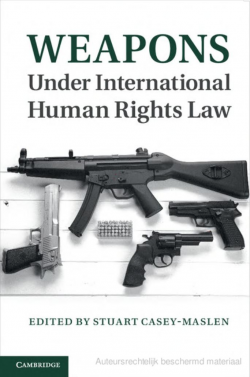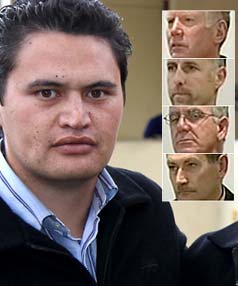Police deny pepper-spraying child
Last updated 15:56 09/09/2011
Police are accused of pepper-spraying a child while trying to restrain its uncooperative father in Whakatane.
At the sentencing of Siale Launi Kefu Uhatafe at the Whakatane District Court this week, defence lawyer Julia Murfitt said when police pepper sprayed her client, they also sprayed the child in his arms.
“He’s got the child in hand, the child gets pepper-sprayed,” the court heard.
Police prosecutor constable Chris Howard immediately denied the accusation, telling Judge Louis Bidois “the child was not pepper sprayed” during the September 1 incident.
Uhatafe, who admitted “hanging around” with Black Power gang members, was also tasered during the arrest.
In court, the Tongan-born 26-year-old pleaded guilty to charges of speaking threateningly, resisting police and disorderly behaviour.
He was convicted and discharged for the disorderly offence and was sentenced to 14 days community detention and 40 hours community work on the other two charges.
The offending occurred while Uhatafe was on community detention.
According to the police summary of facts officers were called to an incident of a man threatening his partner on September 1.
On their arrival a “mildly intoxicated” Uhatafe was standing on the front lawn holding the couple’s young child.
He appeared agitated and was swearing and shouting abuse at his partner inside the house.
He verbally abused police and shouted Black Power gang slogans.
Officers arrested him for disorderly behaviour and told him to put the child down.
The summary said he refused and “made efforts to keep the child between himself and police”.
Concerned for the child’s safety, a constable approached Uhatafe and attempted to restrain him.
Police said he resisted and would not follow the constable’s instructions.
“As a result of his continued behaviour the defendant was taken into police custody after being pepper sprayed and the deployment of a Taser.”
It is not clear from the statement where the child was when the man was pepper sprayed and tasered.
Police use pepper spray to subdue agitated or aggressive people at risk of harming themselves or others.
When pepper spray comes into contact with eyes it causes a severe burning pain temporarily.
When it touches skin it can cause tingling and burning pains, and inhaling it can irritate the nasal passage and cause a burning sensation in the throat.
In court Ms Murfitt said the partner wanted Uhatafe home.
She was studying full time and needed him to look after the children.
On the night of the incident he had been drinking and they began fighting, Ms Murfitt said.
Her client went to leave but was bound by the curfew associated with his community detention sentence.
She said the couple decided to call the police to stop the fight escalating.
Judge Bidois asked Uhatafe if he was a member of Black Power.
He replied: “No, I just hang around them”.
Judge Bidois warned Uhatafe that a sentence of community detention at the victim’s house meant he would at her “beck and call” and would have to behave.
“There is no use you jumping up and down and ranting and raving and thinking you’re tough because all you’re going to do is get in more trouble.”
Source: Whakatane Beacon
This latest case however has all the tell-tale signs of police closing ranks and a coverup. First of all there are the claims made by McGregor that frankly just don’t stack up at all. An example being that the victims father was “previously known to Police” and yet the police have now apparently charged the man with giving police false details. It seems to us that this might just be one of those cases where police have set out to harass someone who was known to the police officer involved.
The simple fact is that in the circumstances the alleged assailant was seated in a vehicle and posed absolutely no immediate threat, if any at all, to police or bystanders. Police must also have been aware that there were another two passengers, including a child, in the cabin of the vehicle in question (an extremely confined space) and that international best practice required that the pepper spray should not have been used in any confined space, let alone that of a motor vehicle cabin.
Reading between the lines it seems to us that the driver might just have refused to get out of the vehicle and that the police officer concerned had decided that a blast of pepper spray may have been useful in obtaining compliance. It may also have been the case that the driver then attempted to drive off after the event in an attempt to avoid being sprayed again. As aforesaid none of the polices explanation, including the way in which the broken window came about, adds up. In fact it seems to us to be a complete construct, including the subsequent charges, none of which reflect any offence that would have called for a driver to have been stopped, “randomly” or otherwise in the first instance.
International guidelines on the use and deployment of Pepper Spray.
The use of Pepper Spray has come under close scrutiny since its introduction. Clearly in the Falwasser case the New Zealand police were in serious breach of all internationally recognised guidelines on its use and deployment. This case too is clearly an incident where police have not only breached the human rights of the driver, who is now facing various charges brought by police, but also the drivers ten-year old daughter who required hospitalization and comprehensive medical intervention to prevent further physical damage to the childs health and wellbeing, the childs psychological health however remains an unknown.

The use of pepper spray in exactly this type of scenario is frowned upon internationally. Author expert and editor Dr Stuart Casey-Maslen in the book “Weapons under International Human Rights Law” spells out exactly the limitations which should be applied to the use of this particular weapon, and it is very much a WEAPON.
At page 344, para 2, Casey-Maslen notes:
In its 2009 reports following visits to the Czech Republic and Bosnia and Herzegovina, the CPT highlighted cases of inappropriate use of pepper spray against detainees and stated that it considered that; ‘Pepper spray is a potentially dangerous substance and should not be used in confined spaces………
…In both reports, the CPT recommended that the relevant authorities:
draw up a clear directive governing the use of pepper spray, which should include as a minimum
clear instructions as to when pepper spray may be used, which should state explicitly that pepper spray should NOT be used in a confined space.
Source: Weapons under International Human Rights Law (ISBN-13: 978-1107027879; ISBN-10: 110702787X)
Casey-Maslen/Crowley also point out the European Court of Human Rights view in the case of ALİ GÜNEŞ v. TURKEY (Application no. 9829/07) who also stated that it shared the CPT’s concerns with regard to the use of pepper spray, concurring whole heartedly with the CPT’s recommendations on the use and deployment of the weapon:
39. The Court notes that concerns have been expressed by the European Committee for the Prevention of Torture and Inhuman or Degrading Treatment or Punishment (“the CPT”) over the use of such gases in law enforcement. The CPT considers that:
“… [P]epper spray is a potentially dangerous substance and should not be used in confined spaces. Even when used in open spaces the CPT has serious reservations; if exceptionally it needs to be used, there should be clearly defined safeguards in place. For example, persons exposed to pepper spray should be granted immediate access to a medical doctor and be offered an antidote. Pepper spray should never be deployed against a prisoner who has already been brought under control.” (CPT/Inf (2009) 25)
40. In its reports pertaining to its visits carried out in a number of Member States of the Council of Europe the CPT has made the following recommendations:
“… [A] clear directive governing the use of pepper spray to be drawn up, which should include, as a minimum:
clear instructions as to when pepper spray may be used, which should state explicitly that pepper spray should not be used in a confined area;
the right of prisoners exposed to pepper spray to be granted immediate access to a doctor and to be offered measures of relief;
information regarding the qualifications, training and skills of staff members authorised to use pepper spray;
an adequate reporting and inspection mechanism with respect to the use of pepper spray…” (See, inter alia, CPT/Inf (2009) 8)
41. The Court shares the CPT’s concerns and concurs with the above-mentioned recommendations.
Source: ALİ GÜNEŞ v. TURKEY (Application no. 9829/07)
There is of course much international, Commonwealth and New Zealand case-law available that would tend to suggest that the New Zealand police, in the case of ten-year old Amy, certainly breached her human rights under international law, the local Human rights Act, Bill of Rights Act and the various human rights treaties that New Zealand is a signatory to.

Rawiri Falwasser, another victim of the New Zealand police’s use and abuse of pepper spray.
The injuries sustained by Amy were most definitely NO accident. For the police to even suggest that this serious, egregious and quite obvious negligence by a trained police officer can somehow be attributed to some sort of accident, whats more allegedly caused by the actions of another, is an insult to the intelligence of anyone with half a brain. These are piss poor excuses that would certainly be very unlikely to sway the intellect of any competent Judge.
Whats more the New Zealand police, in regard to both Jack Kira and daughter Amy, breached their rights as set out in section 9 and quite possibly sections 21 and or 22 of New Zealand’s Bill of Rights Act 1990. Not to mention various applicable sections of New Zealand’s Human Rights Act 1993
It was held in the Falwasser case that the use of Pepper spray was an excessive use of force and a thus a serious breach of Falwasser’s human rights. Likewise this is obviously the likely scenario in the police officers assault on 10-year-old Amy.
Forget the “alleged” offending of Amy’s father, Jack Kira, as claimed by police. Almost identical charges were employed by the New Zealand police in a 2006 case in an effort to discredit another victim of exactly this type of police abuse of human rights. In fact when it come to New Zealand police corruption or negligence cover-ups its almost certainly always par for the course that such abuse of legal process is employed by police in their naferious endeavours to shift focus and or blame;
The 35-year-old man who was sprayed has yet to be identified. He is due to appear in Waitakere District Court tomorrow facing charges of resisting arrest and assaulting a police officer.
Source; Inquiry ordered over police pepper spray incident (New Zealand Herald, May 7th, 2006)
This case, as far as LF can see, is solely about the completely disproportionate police response, serious abuse and negligent behaviour of at least one New Zealand police officer – whether or not police used excessive force in the case of Mr Kira and whether or not, in that case of his wife and daughter Amy, both passangers in the vehicle, and the subsequent injuries Amy sustained (known and as yet to be established); that a police officer acted negligently in deploying pepper spray in a CONFINED space in contravention of internationally accepted best practice and human rights laws.
This also raises the question of the New Zealand police’s own protocols around the use of pepper spray, a matter that was supposed to have been dealt with following the aforementioned May 2006 allegations, as was reported at the time:
Inquiry ordered over police pepper spray incident
May 7th, 2006
The Office of the Police Commissioner last night ordered an inquiry after pepper spray was allegedly used on a handcuffed man lying on the ground outside the celebrity Fight-For-Life event.
Video footage has emerged which shows an officer spraying the handcuffed man in the face in the carpark outside the glamour boxing fundraiser.
The clip has “amazed” top lawyers and caused Police Minister Annette King to ask for an urgent explanation from Police Commissioner Howard Broad.
Ms King said through a spokesperson she would ask Mr Broad for an explanation of the protocols for using pepper spray – and if the rules were
followed in this case.
The Office of the Commissioner last night agreed with the minister and announced that the incident would be “fully investigated”.
Source; New Zealand Herald
Also of concern is the fact that this incident has brought to light the fact that, despite the abuse of pepper spray having triggered at least one formal New Zealand police inquiry as far back as 2006, officers are still seemingly not capable of adhering to police codes of deployment and or conduct.
I seems to us that the New Zealand Police Know only to well that they’re in trouble, with a capital “T”; the language used by District Commander Supt McGregor and the media spin employed by police to attempt to apportion blame for the officers behaviour to the victims, not withstanding that there is little if any relationship to the officers use of excessive force, without trial, are all indicative of an attempted police smear and coverup.
Given the history of this type of systemic abuse by police team Lauda Finem will be taking a close interest in this case.
LF would therefore like to hear from those who have been caught up in the latest case of New Zealand police using a weapon of last resort, completely unwarranted and excessive force in the circumstance; obviously with a complete disregard for the safety and human rights of the three occupants of the vehicle subjected to the so-called “random” traffic stop and search.
It is our view that this is a case where the events and circumstances surrounding the assault on 10-year-old Amy and her parents need to be tested before the courts, using a civil tort, as was the case in Falwasser v New Zealand Attorney General





1 Comment
Keep up the good work LF, I work in MSM and the journos are beholden to the police.